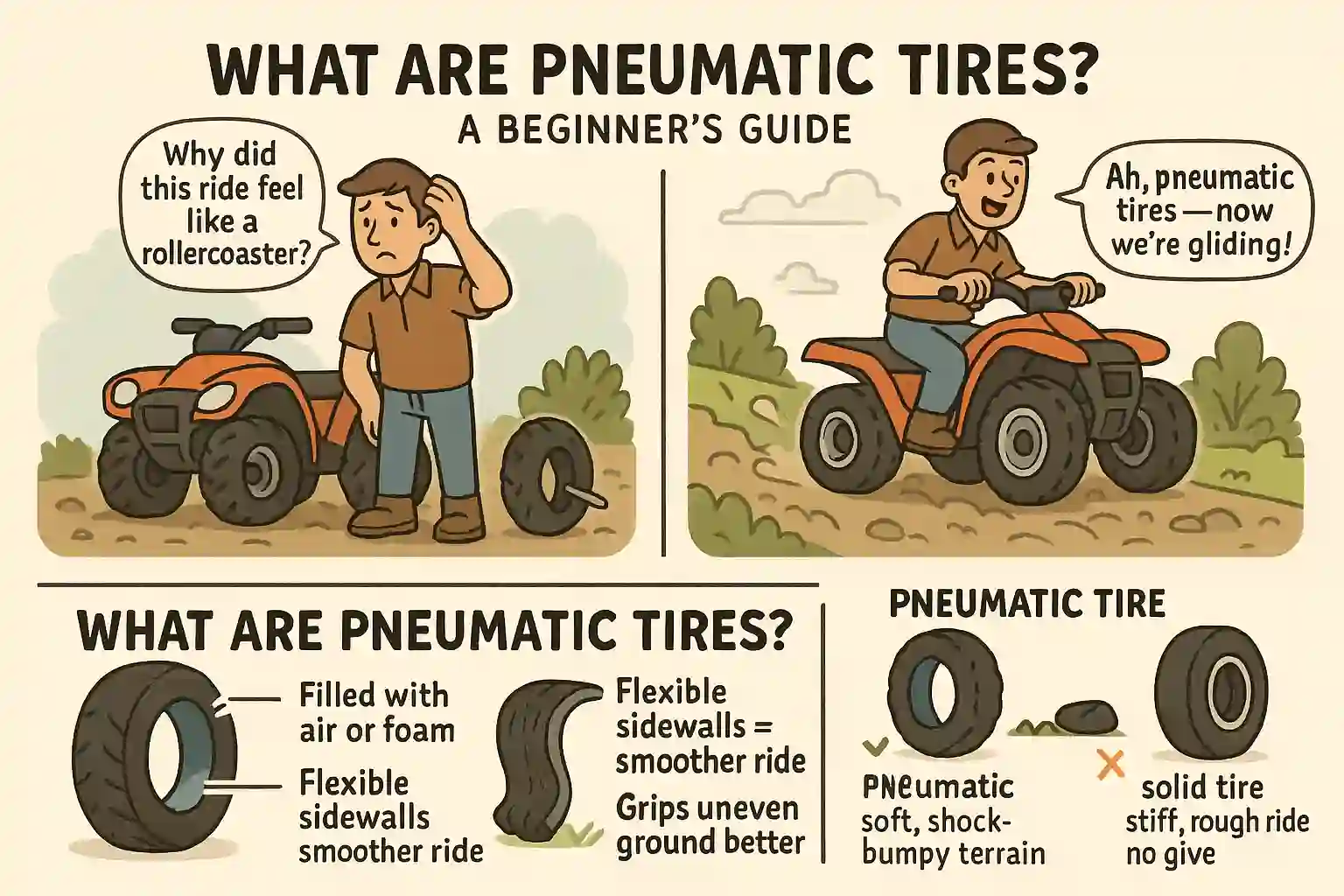I still remember the first time I asked myself, what are pneumatic tires? I was struggling to choose the right tires for my old ATV, wondering why some tires seemed to glide over rough trails while others made the ride feel like a rollercoaster. Pneumatic tires, as I found out, are those air- or foam-filled rubber tires that help absorb shocks and handle uneven ground like champs. In this guide, I’ll share what I’ve learned — from what pneumatic tires are filled with to what they’re made of — so you can see why they’re such a smart choice for many outdoor jobs. Stick with me, and I’ll help you figure out if pneumatic tires are right for you
What Are Pneumatic Tires?
If you’ve ever driven over bumpy ground and felt like your teeth were about to rattle out, you’ll understand why I started looking into what pneumatic tires are. Simply put, pneumatic tires are tires made of tough rubber and filled with air or foam. This makes them soft enough to cushion your ride and strong enough to handle rough or uneven ground. That’s why you see them on everything from forklifts to bikes to ATVs — they help smooth out the bumps so you don’t feel every rock or pothole.
What makes pneumatic tires different is the way they handle pressure. Unlike solid tires, these have an air pocket or foam inside that works like a shock absorber. I like to think of it as the difference between walking on hard tiles versus a soft yoga mat. The air (or foam) lets the tire flex and grip better, which gives you more control, especially on tricky surfaces. Whether you’re hauling heavy loads outside or riding on a dirt trail, this type of tire can make all the difference in comfort and safety.
From my experience, switching to pneumatic tires on my ATV turned a bone-shaking ride into something much smoother. They’re ideal when you need that mix of traction, comfort, and durability. So, when someone asks what a pneumatic tire is, I tell them it’s the tire that saves your back on the job!
What Are Pneumatic Tires Filled With?
When people first hear about pneumatic tires, one of the most common questions is, what are pneumatic tires filled with? The simple answer is air — or sometimes nitrogen. This air gives the tire its shape and helps it absorb bumps and shocks. It’s what makes these tires feel soft on rough ground while still being strong enough to carry heavy loads. Think of it like having a cushion between you and every bump on the road.
Some pneumatic tires are also filled with foam. Foam-filled pneumatic tires work well in places where sharp objects might puncture a regular air-filled tire. I’ve used both air and foam-filled tires over the years. For example, when I worked on a property with a lot of nails and debris, switching to foam-filled tires saved me from constant flats. The foam made the tires heavier, but I didn’t have to stop work to patch holes — that was a game changer!
Air-filled tires are great if you want a smoother, lighter ride, while foam-filled tires are better if you need peace of mind in rough, risky areas. Either way, what pneumatic tires are filled with plays a big role in how they perform and how long they last. I always suggest choosing based on where and how you’ll use them.
What Are Pneumatic Tires Made Of?
So, what are pneumatic tires made of? The quick answer is: durable rubber on the outside and either a tube or a tubeless inner design that holds air or foam. That outer rubber layer is tough — it has to be. It’s what grips the ground and protects the inside of the tire from wear and tear. The inner part, whether it’s tubed or tubeless, keeps the tire’s shape and helps it handle bumps and heavy loads. This combo is what gives pneumatic tires their great traction and shock absorption.
In my own experience, I noticed how much the rubber quality matters when I was working on a landscaping job. I had cheap tires at first, and every sharp rock felt like it might split the rubber. After switching to better-quality pneumatic tires, my ride over rocky paths was way smoother, and I didn’t worry about damage as much. Good rubber and a solid inner structure make all the difference, especially when the terrain is less than friendly.
Most pneumatic tires today use special rubber compounds that resist cuts and scrapes. The inner part — the tube or the air chamber — is designed to hold pressure without leaking easily. Tubeless tires are common in many vehicles now because they’re lighter and easier to repair if you get a puncture. So if you’re wondering what pneumatic tires are made out of, just think: tough rubber outside, smart inner design inside!
Pneumatic Tires Meaning — What Makes Them Different?
So, what does pneumatic tires mean when you hear that term? Simply put, pneumatic tires are hollow tires filled with air or foam that give you a smoother, safer ride over rough or bumpy ground. That’s what sets them apart from solid or cushion tires. Pneumatic tires flex and absorb shocks, almost like a pillow for your vehicle, while solid tires stay stiff and don’t cushion as well. This difference can really change how a machine handles uneven ground or heavy loads.
A key feature of pneumatic tires is that hollow design. Pneumatic tires are different because they’re made to be air- or foam-filled, with treads that grip surfaces better than smooth, solid tires. The treads dig into dirt, gravel, or grass, giving you the traction you need when things get slippery or uneven. I first noticed this on my forklift when I moved between a concrete slab and a gravel yard — the switch felt seamless thanks to the grip and give of the tires.
Compared to solid tires, pneumatic ones handle mixed terrain much better. Solid tires might work well on smooth floors indoors, but they can feel harsh and clunky outside. Pneumatic tires, on the other hand, smooth out the ride and help protect your equipment. When I switched to pneumatics on my small loader, I could tell the difference right away — fewer jolts and more control, even on bumpy ground.
Pneumatic tires is great because they combine shock absorption, grip, and flexibility, making them a smart choice for outdoor work.
Also Read: Remote Control Car Tyre
Why Are Pneumatic Tires Used So Often?
Pneumatic tires are used in many places because they give a smooth ride. Solid tires do not. The air inside acts like a soft pad. It helps with bumps. It makes the ride feel better and keeps things from shaking too much. That’s why bikes, ATVs, forklifts, and tractors use them.
Pneumatic tires are good for grip and comfort on bumpy roads.
These tires are great for outside and off-road use. I once put them on my ATV before a trail ride. What a change! The tires rolled over rocks and bumps with ease. I felt much safer. From wheelbarrows to forklifts, these tires help move over rough ground.
Another reason is comfort. Solid tires can feel stiff and rough. Pneumatic ones are soft. They make the ride feel nice, even on hard ground. I saw this during long yard jobs. Tools with these tires were much easier to push.
Pneumatic tires are strong, soft, and easy to use — that’s why they are so common.
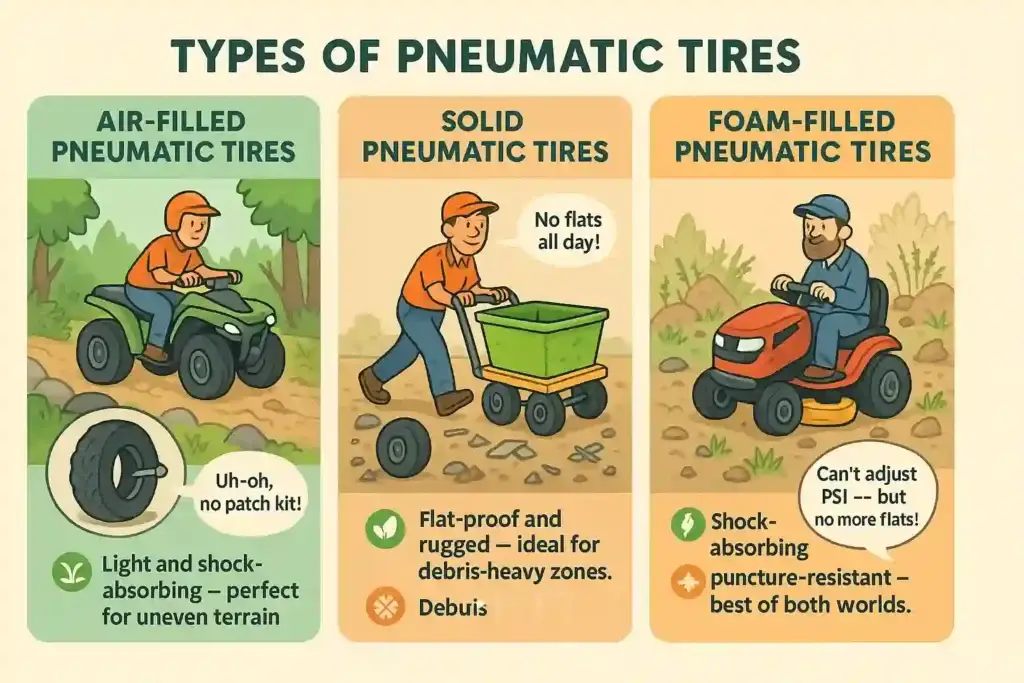 Types of Pneumatic Tires
Types of Pneumatic Tires
When I first started dealing with outdoor equipment, I had no idea there were different types of pneumatic tires. I thought a tire was just a tire. But once I started hauling loads, riding trails, and pushing carts over bumpy ground, I realized — the type of pneumatic tire you choose really matters.
So, what are the main types of pneumatic tires? They generally fall into three categories: air-filled, solid pneumatic, and foam-filled. Each has its strengths, depending on how and where you plan to use them.
Air-Filled Pneumatic Tires
These are the classic ones — filled with compressed air (or sometimes nitrogen). You’ll find them on bikes, ATVs, wheelbarrows, and even cars. Why? Because they’re light, flexible, and give you the smoothest ride.
Short answer: Air-filled pneumatic tires are soft and absorb shocks, making them great for bumpy or uneven terrain.
I remember riding my ATV through forest trails with regular tires. Every rock and root rattled my bones. Swapping to air-filled pneumatic tires made the ride buttery smooth. The tires hugged the ground, absorbed the shocks, and gave me better control.
Just keep in mind — they can go flat. A sharp nail or thorn, and boom — you’re stuck unless you carry a patch kit or air pump.
Solid Pneumatic Tires
Now, if you’re dealing with sharp debris — like screws, glass, or metal scraps — solid pneumatic tires are your best friend. These look just like regular pneumatic tires, but there’s no air inside. They’re made of solid rubber or rubber with an internal structure that mimics the cushion of air.
Short answer: Solid pneumatic tires won’t go flat and are perfect for harsh job sites or industrial use.
When I helped a friend clear out an old warehouse lot, we used a cart with solid pneumatic tires. There were nails everywhere, and I didn’t have to stop once for a flat. They were heavier, sure, and didn’t absorb bumps quite as well — but the peace of mind was totally worth it.
If you’re on rough terrain with lots of puncture hazards, these tires will save your time and sanity.
Foam-Filled Pneumatic Tires
These are like a middle ground. Foam-filled tires start as regular air tires, but they’re injected with a dense polyurethane foam. This foam hardens just enough to keep the tire shape and absorb bumps — without the risk of a blowout.
Short answer: Foam-filled pneumatic tires combine shock absorption with puncture resistance — ideal for risky outdoor work.
I used these on a lawn tractor for a property surrounded by thorny bushes and sharp gravel. I didn’t want to sacrifice ride comfort, but I also didn’t want to keep patching tubes. Foam-filled tires gave me both — they were heavier than air tires, but never went flat.
They do cost a bit more, and once the foam is in, you can’t change tire pressure like you can with air. But in high-risk areas, they’re worth every penny.
Which One Should You Choose?
That depends on where you’re working and what matters more to you — ride comfort or no downtime.
If you’re rolling over smooth but uneven terrain (like trails or lawns), go with air-filled.
If flats are a constant headache, especially in industrial or junk-filled areas, go with solid pneumatic.
And if you want the best of both worlds — a softer ride without the flats — foam-filled is a smart upgrade.
I’ve used all three, and trust me — the right tire can make your day easier and your ride smoother. It’s not just about rolling; it’s about rolling smart.
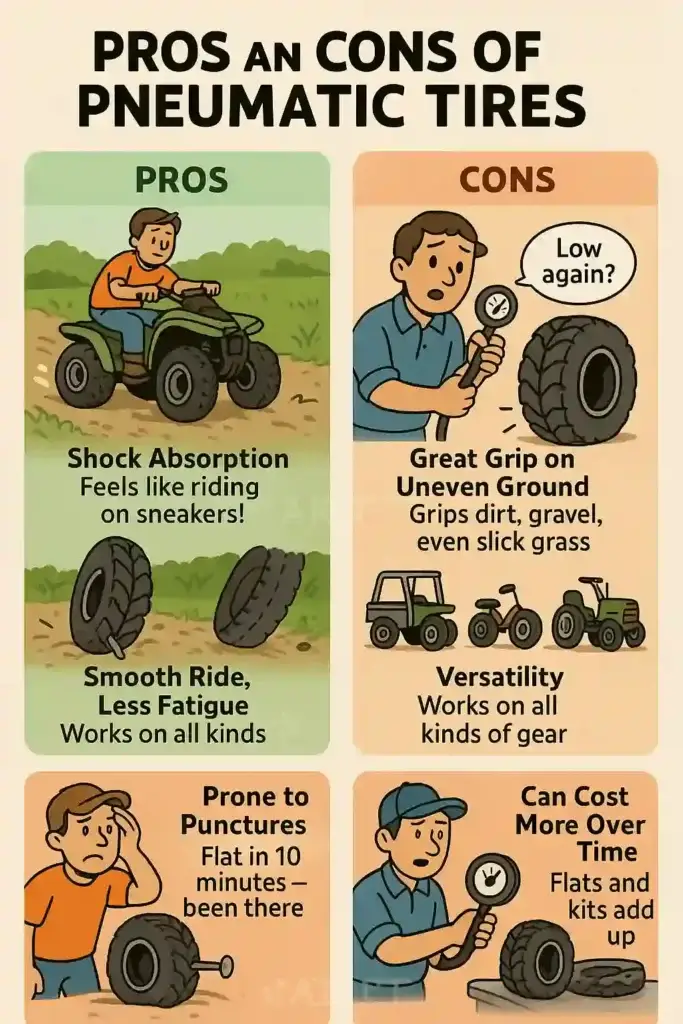 Pros and Cons of Pneumatic Tires
Pros and Cons of Pneumatic Tires
Like anything in life, pneumatic tires come with ups and downs. When I first switched to them for my ATV, I was blown away by the smoother ride. But later, when I got a flat in the middle of a trail? Let’s just say I learned the hard way that not all terrain is friendly.
So, what are the pros and cons of pneumatic tires? Here’s what I’ve found from real use — the good, the bad, and the “wish I had known sooner.”
Pros of Pneumatic Tires
Pneumatic tires offer shock absorption, better grip, and a smoother ride — especially on uneven or rough ground.
- They absorb shocks like a dream.
If you’ve ever hit a pothole with solid tires, you know that jolt. Pneumatic tires, on the other hand, cushion the impact. That’s because they’re filled with air or foam that flexes under pressure. It’s like walking in sneakers versus stiff dress shoes.
- Great grip on rough or soft surfaces.
The tread design plus the tire’s flexibility helps it grip dirt, grass, gravel — you name it. I’ve ridden through mud, gravel, and even slick grass without sliding around, all thanks to that extra traction.
- Smooth ride = less fatigue.
Whether you’re pushing a heavy wheelbarrow or driving a forklift, a smoother ride means less strain on your body. I noticed this a lot during long landscaping jobs — my arms and back didn’t feel beat up at the end of the day.
- Versatility across machines and jobs.
From ATVs and carts to tractors and wheelchairs, pneumatic tires work just about anywhere you need comfort and control. They’re the go-to choice when solid tires just don’t cut it.
Cons of Pneumatic Tires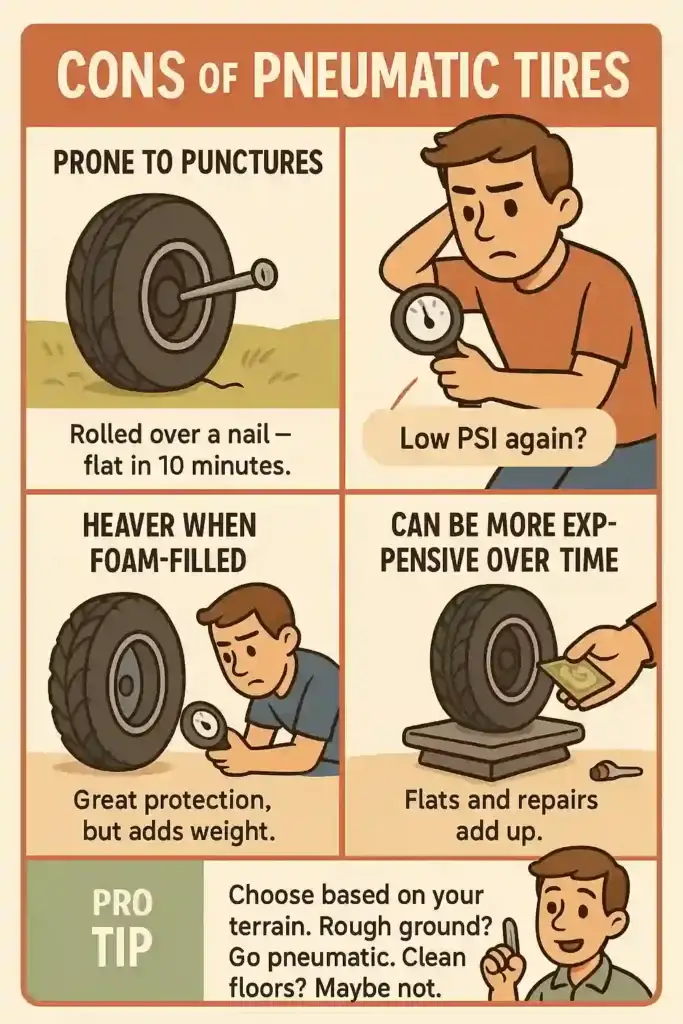
Pneumatic tires can go flat, need regular pressure checks, and are heavier — especially when foam-filled.
- They’re prone to punctures.
This is probably the biggest downside. One day, I rolled over a nail I didn’t see. Ten minutes later, I was stranded with a flat. If you work around sharp debris, you’ll want to think twice about air-filled tires — or keep a spare.
- They need maintenance.
Air pressure doesn’t stay perfect forever. I’ve had days where low pressure made my cart feel sluggish. Checking the tire PSI now is just part of my routine. It only takes a minute, but it’s easy to forget.
- Foam-filled tires add weight.
If you go the foam-filled route for extra puncture protection, keep in mind they’re heavier. It’s not always a big deal, but if your machine is sensitive to weight, you might notice it.
- They can be more expensive over time.
Frequent flats or replacements can add up. Especially if you don’t have the tools to patch them yourself. I’ve had to buy a couple of tire repair kits just to avoid waiting for service.
In my experience, the benefits usually outweigh the downsides, especially if you’re working outdoors or riding over rough ground. But like with most tools, it’s all about the right match for the job.
If you’re working somewhere clean and smooth, maybe you don’t need the bounce and grip. But if your path is full of potholes and gravel? Pneumatic tires might just save your back — and your sanity.
Let me know if you want help choosing between air, foam, or solid types. I’ve tested them all and I’m happy to share what’s worked best in different situations!
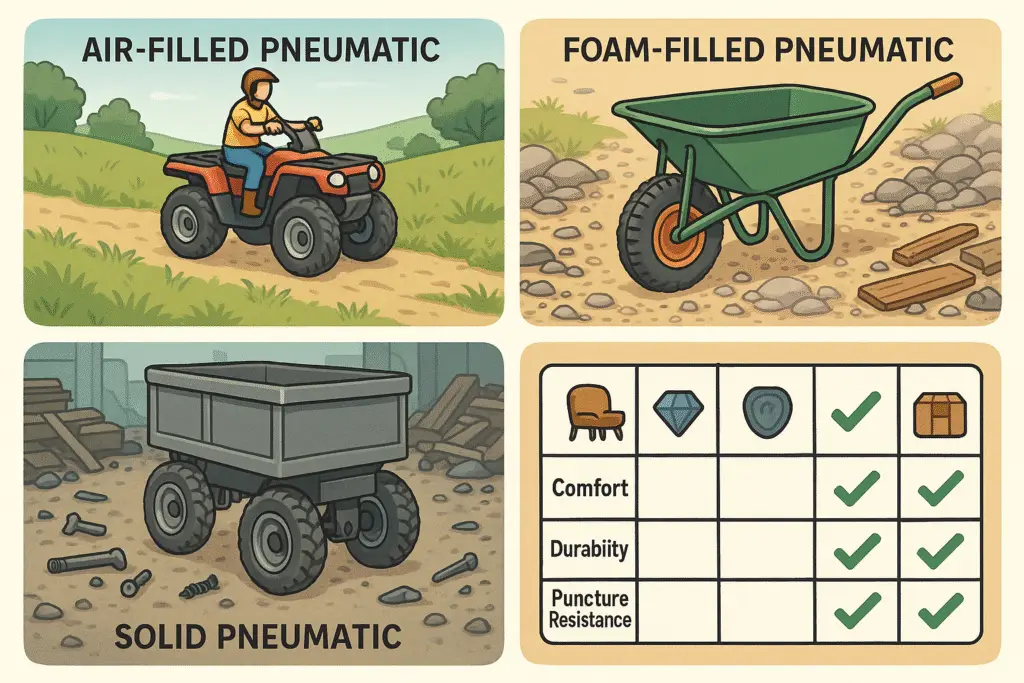 How to Choose the Right Pneumatic Tire for Your Needs
How to Choose the Right Pneumatic Tire for Your Needs
Choosing the right pneumatic tire can feel like a guessing game — I’ve been there. The first time I had to pick tires for my ATV, I didn’t think much about weight, terrain, or puncture risk. I just picked the cheapest ones. Let’s just say… I paid for that mistake later with a flat tire halfway through a trail ride. Lesson learned.
So, how do you choose the right pneumatic tire? Start by thinking about where you’ll use it and what kind of work it’ll handle.
Consider the Terrain First
Short answer: The type of surface you drive on most often should guide your choice.
If you’re rolling over soft dirt, gravel, or grass, air-filled pneumatic tires are a great match. They flex, they grip, and they give you that smooth ride you’ll really appreciate over long distances.
On the other hand, if your job site is littered with nails, screws, or sharp rocks (like a scrapyard or an old construction site), solid or foam-filled pneumatic tires will keep you moving without flats. I’ve had foam-filled tires save me hours of downtime on projects with hidden hazards.
Think About Load Weight
Short answer: Heavier loads need stronger tires with better structural support.
If you’re hauling heavy gear or equipment, choose a tire with a reinforced sidewall and a higher load rating. Foam-filled and solid pneumatic tires usually hold up better under pressure — literally.
I once overloaded a cart with air-filled tires, thinking it’d be fine. The tires sagged like a deflated balloon and made it impossible to steer. Since then, I always check the load specs before buying.
Watch Out for Puncture Risks
Short answer: In high-risk areas, solid or foam-filled tires offer peace of mind.
Ask yourself: how often do you work around debris, thorns, or broken glass? If your answer is “all the time,” foam-filled or solid pneumatic tires are worth the cost. They’re heavier, yes — but you won’t be pulling out a patch kit every other week.
For clean fields or light yard work, though, stick with air-filled. They’re lighter and easier on your back, especially when pushing equipment manually.
Choose Based on Comfort vs. Durability
Short answer: Air tires = more comfort. Solid/foam = more durability.
If you want a comfy ride and you’re not worried about flats, air-filled tires will serve you well. If you’d rather never deal with a tire pump or flat again, solid or foam-filled are the way to go.
I’ve personally leaned toward air-filled tires when comfort mattered more — like on long ATV rides. But when I was hauling supplies through a rough warehouse lot, I didn’t even think twice about using solids.
Quick Checklist to Help You Decide
Here’s a simple breakdown I wish I had when I was first figuring this all out:
|
Situation |
Best Tire Type |
|
Smooth trails or grassy fields |
Air-filled pneumatic tires |
|
Sharp debris or scrap zones |
Solid pneumatic tires |
| Mixed terrain with some risks |
Foam-filled pneumatic tires |
| Heavy lifting and rough surfaces |
Solid or foam-filled |
|
Want the lightest, softest ride |
Air-filled |
When it comes down to it, there’s no one-size-fits-all tire. But once you figure out what kind of ground you’ll cover, what you’re hauling, and how often you deal with flats — the choice gets much easier.
Still unsure? Feel free to drop me a line. I’ve made almost every tire mistake you can imagine, so I’d be happy to help you avoid them.
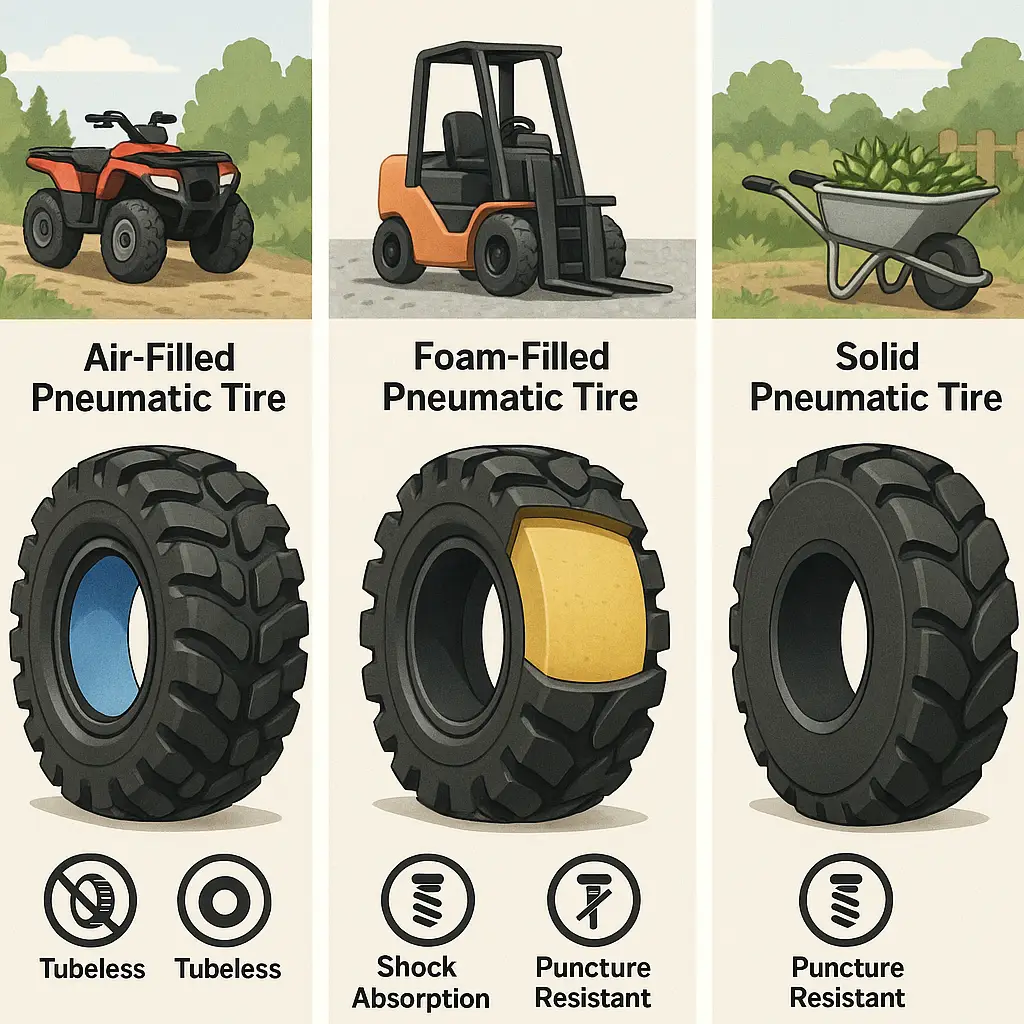 FAQs About Pneumatic Tires
FAQs About Pneumatic Tires
What is a pneumatic tire in simple words?
A pneumatic tire is a rubber tire filled with air or foam. It cushions your ride by absorbing shocks and bumps, making it smoother and safer to drive.
Are pneumatic tires filled with air or foam?
Most pneumatic tires are filled with air, but some use foam for puncture protection. Foam-filled types are heavier but never go flat.
What are pneumatic tires made out of?
Pneumatic tires are made of strong rubber with air or foam inside. Some have inner tubes, while others are tubeless for better durability and support.
Why do forklifts or off-road vehicles use pneumatic tires?
Pneumatic tires give forklifts and off-road vehicles better grip and shock absorption. They work well on rough or uneven outdoor ground.
Are pneumatic tires better than solid tires?
Pneumatic tires ride smoother and offer more traction than solid tires. But solid tires don’t go flat and are better for very rough or debris-filled areas.
What’s the difference between tubed and tubeless pneumatic tires?
Tubed tires have an inner tube to hold air. Tubeless tires hold air directly in the tire and rim, making them easier to repair and lighter to use.
How often should I check air pressure in pneumatic tires?
Check air pressure at least once a week. Low pressure can make the tire wear out faster and make your ride feel sluggish or unstable.
Can pneumatic tires go flat easily?
Yes, air-filled pneumatic tires can go flat if punctured. Foam-filled and solid options reduce this risk but may add extra weight.
What’s the best type of pneumatic tire for off-road use?
Air-filled pneumatic tires are best for smooth trails. Foam-filled or solid pneumatic tires are better for rough or debris-covered terrain.
Are pneumatic tires good for wheelbarrows and carts?
Yes! Pneumatic tires make pushing loads easier by absorbing bumps. Foam-filled options are great if you’re working around nails or sharp tools.
Final Thoughts — My Take on Pneumatic Tires
After using pneumatic tires on everything from wheelbarrows to ATVs, I can confidently say this — they’re worth it when comfort, grip, and flexibility matter. Whether you’re rolling over rocky trails, pushing gear through a bumpy yard, or working outdoors all day, they make the ride smoother and your job easier.
Pneumatic tires are filled with air or foam to absorb shocks, and that simple fact changes everything. The bounce, the ease of movement, the way your equipment feels — it all improves. I used to think any tire would do the job. But once I made the switch, I realized how much strain I had been putting up with for no reason.
If you’re still on the fence, here’s what I tell friends and folks who ask:
👉 Go with air-filled pneumatic tires if you want a light, comfy ride.
👉 Choose foam-filled or solid pneumatic tires if you’re worried about flats or work in harsh environments.
In my experience, it’s not about which tire looks good — it’s about what helps you do the job without slowing you down or shaking you up. And if you’re unsure what type to pick, think about the ground under your feet and how often you’re fixing flats. That usually points you in the right direction.
Need help deciding? Feel free to drop a comment or send your situation my way. I’ve made enough tire mistakes for both of us — and I’d be glad to help you choose the right one the first time.

